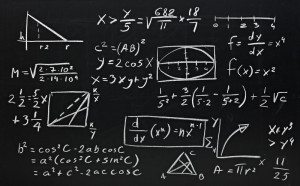 Among the popular basketball analytics these days is one called usage rate. The concept is really quite simple as it merely means the number of possessions in a game that a player utilizes.
Among the popular basketball analytics these days is one called usage rate. The concept is really quite simple as it merely means the number of possessions in a game that a player utilizes.
The formula is easy to compute and only needs 4 standard hoop stats,
- FTA’s
- Assists
- FG’s
- Turnovers.
To calculate a player’s usage rate:
- Multiply FTA’s by 0.44 (This gives you Adjusted FTA’s.)
- Multiply Assists by 0.33 (This gives you Adjusted Assists).
- Add the above two adjusted numbers.
- dd FGA’s.
- Add Turnovers
For example in a recent Big Ten game a player had 14 FTAs, 3 Assists, 15 Field Goal Attempts and 2 Turnovers:
- 14 FTA’s x 0.44=6.16
- 3 Assists x 0.33= .99
- 15 FGA’s= 15
- 2 Turnovers= 2
Total usage rate = 24.15
This per game usage rate, if averaged over the season, would be ranked in the Top 15 in the country. In the 2015-16 NCAA season leaders per game are Kay Felder, 28.3; Kris Dunn, 27.5; Denzell Valentine, 27.0 and Buddy Hield at 25.5. Notice that all play big minutes and all have the ball a lot. An anomaly is Purdue 7-1 soph post man Isaac Haas who only plays 16 minutes a game and doesn’t have the ball in his hands a lot. (More on that later).
On the NBA side, Russell Westbrook is #1 with 34.8; Stephan Curry is #6 with 31.; Kobe Bryant is #9 with 29.7. (More on Kobe later). To see the NBA and NCAA rankings, just search “usage rate” or John Hollinger. This past summer we featured Hollinger’s PER, (player efficiency rating) and usage rate is another metric that Hollinger uses to ascribe value to players. Notice that the NBA #’s are generally higher across the board. Besides being better players across the board, the more important factor is the higher number of minutes played. Obviously, the same analogy will hold true for the fewer minutes in a high school game.
So, what are the takeaways for the many coaches who haven’t already utilized usage rate as a tool for analysis?
- A high usage rate isn’t necessarily good. Go back to Kobe; he’s utilizing a high number of possessions but inefficiently-35% FG and 26% 3 PT FG. The combination of high usage rate and poor efficiency isn’t a recipe for success.
- A player can have high usage rate in short minutes and away from the ball. If that player is efficient also, maybe the morale of the story is that player needs to be on the floor more.
- Like any stat or metric, usage rate means less standing alone than when used together with other stats/metrics.
- Coaches can affect usage rates with playing time, player placement and styles of offense.
- Above all, usage rates can help coaches put their best players in positions to succeed more often and put lesser players in “managed” situations more often and dangerous positions less often.


